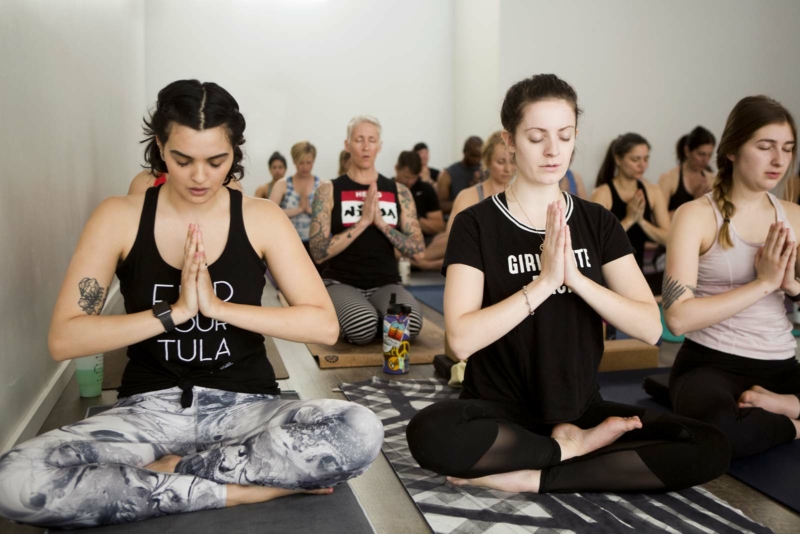We hear it a lot! “I’m not good at meditation”. But the most important part of learning to meditate is just simply taking your seat and observing! Sure, it sounds easy – but its not. Your body might start to ache, your feet might fall asleep, you might get the figits! So why even begin??
The medical and psychology community is confirming what yogis have known for thousands of years! Meditation works!
Meditation is a state of deep concentration. It brings the mind to a focus, a “one-pointedness.” In doing so, it blocks out or quiets the typical mental chatter most people carry around in their mind. Buddhists speak of the “monkey mind,” the mind that darts from topic to topic. The focus can be the breath, the sensations of the body, a mantra or a sound. Or the focus can be a static or moving image.
Benefits of Meditation:
• Promotes clarity and calm and inner peace
• Increases the ability to focus and concentrate
• Reduces stress and can enhance creativity
• Can improve symptoms of anxiety and depression
MEDITATION TECHNIQUES: There are a lot of meditation techniques out there! You don’t have to pick just one! Below are some more well known techniques to get you started!
Transcendental Meditation: Transcendental meditation is a technique for avoiding distracting thoughts and promoting a state of relaxed awareness. The late Maharishi Mahesh Yogi derived TM from the ancient Vedic tradition of India. He brought the technique to the U.S. in the 1960s. While meditating, the person practicing sits in a comfortable position with eyes closed and silently repeats a mantra to focus your concentration. According to supporters of TM, when meditating, the ordinary thinking process is “transcended.” It’s replaced by a state of pure consciousness. In this state, the meditator achieves perfect stillness, rest, stability, order, and a complete absence of mental boundaries.
Guided Visualization: When the focus of a meditation is an image, the meditation becomes visualization. Visualization is a specific kind of meditation. Visualization is sometimes called mental imagery. If you are performing a simple visualization, you picture a setting, another person or a sequence of events — something outside yourself.
Walking meditation: Unlike seated meditation, when walking your eyes are open, body is standing and moving, and there is a bit more interaction with the outside world. Many people especially beginners, find walking meditation easier than seated meditation. Because the body is moving, it is easier to be mindful of the body sensations and anchored in the present moment.
Mindfulness meditation: Mindfulness meditation is unique in that it is not directed toward getting us to be different from how we already are. Instead, it helps us become aware of what is already true moment by moment. We could say that it teaches us how to be unconditionally present; that is, it helps us be present with whatever is happening, no matter what it is.
Zen Meditation: Zazen is a type of meditation unique to Zen Buddhism. It involves focusing on the breath and remaining in the present moment. To begin practicing Zen meditation, find a comfortable place and position. Try short sessions where you focus on your breath. You mind may wander but continue to draw your attention back to the breath. This may be difficult, but you’ll eventually find a meditation routine that works for you. Breathe in through the nose, letting the air fill your lower abdomen as if it were a balloon, then gently release it with a slow, deep breath out… in and out, in and out. Count one on the in-breath, two on the out-breath, three on the in-breath, four on the out-breath, and so on—up to ten. Then begin at one again. If it is more comfortable for you, you may count the out-breaths only and follow the in-breath without counting. If a thought causes you to stray from the counting, just take notice of that, return your focus to the breath, and begin counting again, starting at one.
Yoga Nidra: Yoga nidra, or yogic sleep as it is commonly known, is an immensely powerful meditation technique, and one of the easiest yoga practices to develop and maintain. While the practitioner rests comfortably in savasana (corpse pose), this systematic meditation takes you through the Koshas or five layers of self, leaving you with a sense of wholeness.
Loving-Kindness Meditation Loving-kindness, or metta, is unconditional, inclusive love, a love with wisdom. It has no conditions; it does not depend on whether one “deserves” it or not; it is not restricted to friends and family; it extends out from personal categories to include all living beings. A loving kindness meditation allows you to meditate on the feeling of love.
STARTING A MEDITATION ROUTINE: Now that you have some types of meditations to choose from, here are some tips to get started!
• Create a quiet space where you feel comfortable and won’t be disturbed easily
• Find a comfortable seat
• Try to meditate at a similar time every day to help form the habit
• Set a timer so you won’t feel the need to watch a clock. Start at small and build your time from week to week
Check out our free meditations to get you started here! https://www.tuladharayoga.com/free-meditations





